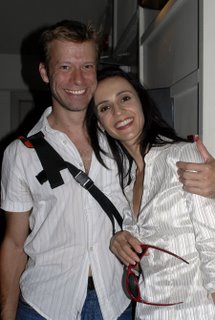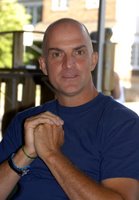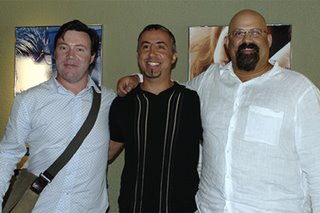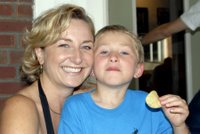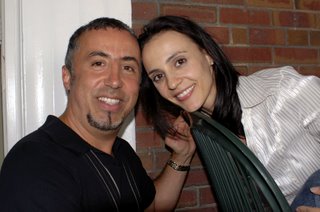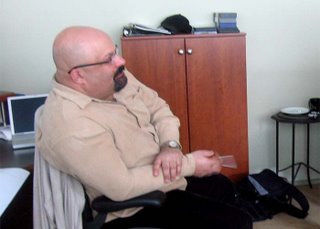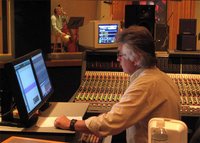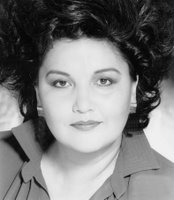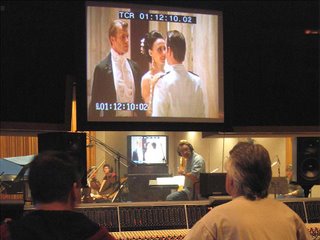
Well, it has been a long time hasn't it!? The two months since the last post have been very full, not only in my life, but in the life of
Roxana, as every frame of her shot footage is logged, muddled over, counted, reviewed and noted. In February, the music was recorded and in March the first rough assemblies were hung together. There is still much work ahead but also much to celebrate.
One of the most unusual elements of this production is the fact that guidetrack music was used during shooting for the ballet sequences, and the real music laid down later. The music tracks for
Roxana, composed by Alexina Louie and Alex Pauk, were recorded on February 13th at CBC. In a small space with just seven instrumentalists conducted by one of the composers, the musical vision came to life. On the eve of Moze jetting off to London to visit family, he took a moment to share with me some updated thoughts on the process. The pix you see were taken during the recording sessons.
 What were the unique features about this particular recording session, in comparison to your previous movies?
What were the unique features about this particular recording session, in comparison to your previous movies?Moze: I must say that the music in
Roxana presented more challenges than in any of my past films. But I was helped in great part by the composers understanding, generosity and musicality. You see, the music in the film – and I’m referring to all the dance music, in particular – was composed after the fact, meaning it was created once all filming was completed and we had embarked upon editing. For various reasons, but having mainly to do with the composers’ hectic performing and composing schedules, we had to use “temp” tracks in both rehearsals and shooting as the final dance could not be made in ready in time. Roberto (the choreographer) and I ended up using various pieces of music from a variety of sources such as Prokofiev, Bernard Hermann (particularly his scores for Hitchcock), as well as music by Brian Keane, the Dirty Dozen Brass Band and the Cherry Poppin Daddies – quite an eclectic pool, for sure!
It was therefore quite the daunting task for Alex [Pauk] and Alexina [Louie, composers] to sit down with the edited dance sequences, created and shot to a different music altogether, and write new compositions that would be in keeping with not only the spirit and feel of the original pieces but maintain the tempo, timing and all flourishes and physical synchronizations between the choreography and the music. Actually, now that I think about it, the whole thing feels like an impossibility (and maybe even a bit wild), but we had no choice but to follow this route and I’m happy to say our sweat and toil has paid off. The music that Alex and Alexina have written is certainly different from what we originally started with (which was the point, anyway) but I think they’ve captured a sense of continuity and dramatic development that could not have been possible with the pastiche of the original music. We also now have the opportunity to incorporating many of the themes, ideas, textures and colours contained in the dance music into the underscoring of the dramatic scenes. Undoubtedly, it will allow us to create a sense of unity that will be unique alone to Roxana and the world she inhabits in the film.
 What intrigued you about working with Alexina and Alex?
What intrigued you about working with Alexina and Alex?Moze: I have been lucky to work with very gifted composers. What drew me to the Alexes is that they have their own orchestra and have composed for both large symphonic bodies and smaller ensembles. They’ve also created many scores for films such as
The Five Senses and
Last Night and understand the dramatic connective needs between action and music. In a film with a heightened sense of reality and drama like
Roxana, I needed composers who had experience with both of these elements and were not afraid of sounding baroque or unashamedly extravagant. You see, nothing in
Roxana is real: everything from the décor, costuming, hair, make-up, costuming and right down to the staging and acting has been heightened in such a way to create a world that’s entirely on its own. And the music has to fit into that scheme somehow which I’m happy to say that the Alexes have absorbed into their overall score.
 What was exciting about watching the recording happen?
What was exciting about watching the recording happen? Moze: The recording of the dance music was utterly thrilling as it was the first time I had sat before an orchestra recording for a film. From the moment I arrived and found the musicians tuning up, to watching the Alexes make last minute adjustments, to seeing the film unspool and having Alex conduct the music through its labyrinthine twists and turns, it was all completely exhilarating. It was also fascinating to watch the musicians “double-up” on certain parts so that certain sections would have a fuller sounding horn or string section or watch a musician make multiple passes on a number, each time adding a new instrument and layer of sound. There were also a couple of instances where we wanted a different feel to the music, in which case Alex would have the musicians mark the adjustments on their sheet music and we’d record it again. All in all, the musicians (mostly from the Esprit Orchestra which the Alexes conduct) were frighteningly good for they had not seen the music before coming in that morning. I was quite impressed to see them look over the sheet music and then play it so well the first time that it looked like they had been rehearsing for days!
 Was this the first time you had heard the music?
Was this the first time you had heard the music?Moze: I had heard the music once before the actual recording but only a very sketchy, computer-generated piano version. At first, I was quite confused (and maybe even a bit alarmed!) as I could not hear all the nuances that would go into making the pieces full and dramatic. But the Alexes walked me through each music piece, pointing out that one particular, metallic-sounding “ding-ding” was in fact the entire string section playing their assess off or another forlorn “bong-bong” was in fact the horns coming at you full force. Computers are great but they can never replace the real thing!
 How will the music affect the editing of the film in terms of its pacing/rhythm/performance...?
How will the music affect the editing of the film in terms of its pacing/rhythm/performance...?Moze: One of the big challenges facing us in editing, now that the dance music has been composed and recorded, is to create a deeper sense of synchronization between the music and the performances. You see, what you’ll be hearing was not what the dancers heard when they were rehearsing and shooting. In the first assembly of the film, this was apparent somewhat in a couple of instances, but Jeff (the editor) has done an amazing job of bridging those moments and creating a fuller sense of harmony. We’ll also have an opportunity to have another go at some of those dance sections in the final scoring but so far everything is coming through quite nicely. It’s been a very different way of working but it has only been made possible by the awesome talents of everyone involved in this post-production phase, particularly Alex Pauk, Alexina Louie and Jeff Bessner.
Next up: the rough cut!



